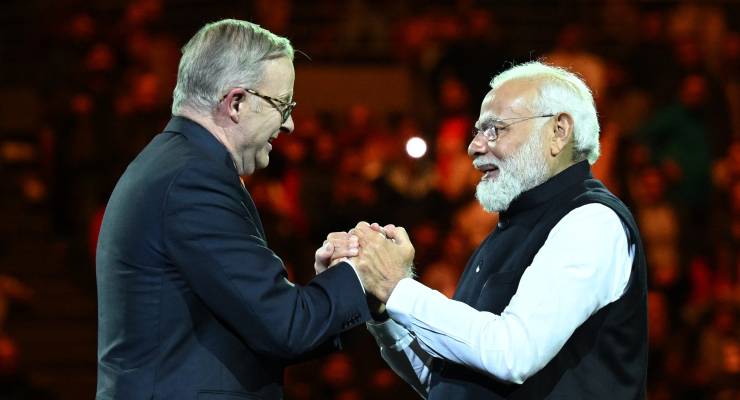
Narendra Modi arrived this week for an official visit to Australia. When he first came to Australia in November 2014, the recently elected Indian prime minister was still to find his feet on the global stage.
Keen to show the new government meant business, Modi worked hard to establish a rapport with other leaders at the Group of 20 (G20) summit in Brisbane. But in the limelight, Modi appeared nervous, not least in his speech to the Australian Parliament.
Almost nine years on, things are very different. India is the focus of world attention, as the 2023 G20 chair, with an economy growing faster than almost all its competitors. And Modi, now a veteran of dozens of summits and visits, is far more confident abroad.
Indifference and irritations
In the meantime, the relationship between Australia and India has also changed. Twenty years ago, the two countries had very little to do with one another. China’s insatiable hunger for coal and iron ore was the main focus of Australia’s political and business leaders. New Delhi concerned itself with its own economic development and overcoming longstanding differences with the United States.
Things started to shift in the late 2000s, as both Australia and India grew more concerned about Beijing’s burgeoning power and ambition. In 2007, both countries took part in a meeting of the Quad, a diplomatic dialogue also involving the US and Japan. Two years later, Kevin Rudd went to New Delhi and signed a new security agreement. A little later, Australia dropped a ban on uranium sales to India, removing a longstanding irritant in the relationship.
These actions cleared the air, but weren’t quite enough to push the two sides to build a partnership. It took the shock of Donald Trump’s election as US president to provide the necessary impetus. The prospect of Trump putting “America first”, and the possibility the US might not act as expected if a crisis occurred, led to a flurry of diplomatic activity by Australia and India and the reconvening of the Quad in late 2017.
Indo-Pacific partners
Since then, the Australia-India relationship has advanced in leaps and bounds — despite the disruptions caused by COVID.
The biggest advances have been made in the areas of defence and security. The two countries now hold annual leaders’ summits and talks between their foreign affairs and defence ministers. The Australian army, air force, navy and special forces regularly exercise with their Indian counterparts.
The economic relationship has also become stronger, assisted by the growing Indian diaspora and concerted effort by the Australian government. Education has been a particular highlight, with more Indian students flowing to Australian universities and Australian institutions opening campuses in India. The conclusion of an interim trade deal just prior to the 2022 election promises to further boost economic ties.
The Quad is opening up other possibilities for cooperation. Since 2017, it has expanded its agenda to cover everything from artificial intelligence and semiconductors to infrastructure and maritime security. Closer collaboration in the mining and processing of critical minerals such as lithium, used in batteries, discussed within the Quad, particularly interests both countries.
Deals and the diaspora
These issues and more are on the agenda for Modi’s visit to Australia this week. Boosting economic ties is a key priority. A comprehensive trade and investment deal is the ultimate aim.
Both countries also want to draw on the connections and capabilities of the Indian diaspora in Australia, now almost a million strong, to advance this part of the relationship. The new Centre for Australia-India Relations, based in Sydney, will be central to this effort.
At the same time, Modi is looking to the diaspora for more political reasons. His Bharatiya Janata Party (“Indian People’s Party”, or BJP) relies on people of Indian origin across the world, especially in the US, for funds, skills and influence. With a national election looming in 2024, Modi wants to energise and mobilise this crucial constituency to help the BJP to a third consecutive victory.
In Australia, however, the diaspora is divided. Some have long opposed the BJP and criticised its policies, especially concerning India’s 200 million-strong Muslim minority.
But lately a new issue has surfaced in Australia and overseas: a campaign by some Sikh activists for a separate Sikh state, “Khalistan”. Unofficial “referendums”, organised to show support for the cause, have been held in Australian cities. Anti-India and anti-Modi slogans have been daubed on Hindu temples.
Only a small proportion of Australian-based Sikhs support the Khalistan movement. But the issue is causing problems for the Modi government and for the relationship between Australia and India. During Albanese’s recent visit to India, Modi reportedly pressed his counterpart to rein in separatist activism in Australia.
Maintaining the balance
The partnership built between Australia and India is sufficiently robust to manage challenges like the Khalistan movement. And it needs to be. The security and prosperity of both countries depend on closer cooperation to manage Beijing’s push to reshape our region to serve China’s interests.
Australia and India must work together — and with others across the Indo-Pacific — to maintain the balance of power that allows all countries in the region to determine their own futures.
This article first appeared on The Conversation.








So you wrote a whole article about Modi without mentioning his very public involvement in pogroms in India?
https://www.theguardian.com/commentisfree/2023/feb/18/narendra-modi-hindu-nationalism-india-gautam-adani
I mean – I never became a professor of International Relations, Ian, or even studied it. But I thought this would well known fact would affect the relationship between Australia and India. Am I wrong?
Of course you are! Never let ‘well known facts’ get in the way of money. It is a rule so ingrained, so tested, so frequently proven in Australian politics that it might as well be classed alongside Newton or Einstein.
Modi’s complicity in this event was enough for him to be barred from entering the USA for years. When he became PM, however, a blind eye was turned.
Our government rightly always asks China about the Uighurs when there are such love-ins. Did our leader ask Modi about his Muslims?
I was in India in 2010, part of an Australian IT delegation. We visited Gujarat, of which Modi was Chief Minister at the time, and gave an IT presentation to him. The following day, the headline in the Times of India was something like “Modi implicated in murder of 1,000 Muslims”. As Peter Murphy asks, why no mention of those events?
Every week, in New Delhi alone, there are cases of dowry deaths – the response for 40yrs are billboards showing a woman in bridal sari (sic!) with the caption “Bride Burning is a Social Evil”.
At least with suttee they were generally strangled first.
BTW, before the usual suspects leap in and blame Teh Patriarchy, these “kitchen accidents” (as the normal euphemism has it) are always driven by the mother-in-law.
Oh in terms of women’s rights and abject poverty, China is much much better than India.
Albanese’s sycophantic comparison of Modi to Springsteen was, to my mind quite pathetic and embarrassing.
Australia needs leaders, not starstruck fanbois.
As always, he comes over as in Tom & Jerry cartoon as the annoying yappy puppy adulating Spike, the bulldog.
His recent performance in Hiroshima as the wannabe on the sidelines of the G7 was demeaning of this country.
Brilliant analogy, as always, Munin. I was wondering what that wet patch on his trousers was from.
Anyone know how that defamation action bought against the BBC over that documentary is going? You know the one which caused the Indian Police to raid the offices of the BBC